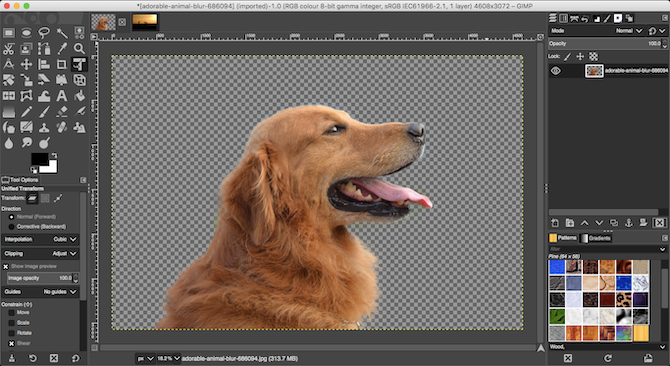

Step 6 - Use the Select by Color Tool to select the background Step 5 - Clean up the extraneous spots with the Eraser Tool A dirty scanner glass can sometimes leave 'dirt marks' on a scanned image that should be removed with the eraser Step 4 - Use the Select by Color Tool to select the background and erase with the Delete key The Select by Color Tool will select all the areas of the same color, even if they are isolated from the area you click in (this does NOT happen with the Fuzzy Select Tool)

Step 3 - Add alpha channel (if there is none, the layer name will be in BOLD characters) NOTE: If there is NO alpha channel, you cannot create a transparent background Step 2 - Crop the signature AND duplicate this layer (just in case you mess up) I find it is a good idea to duplicate the working layer after each step I always make the lower layers invisible to see only the layer I'm working on. Step 1 - Scan image of signature and open the file in the GIMP Here are the steps to clean up a scanned image of a signature to create a transparent background. This technique is illustrated using the Gimp, a free, open source image editor ( ). Although the question concerns a scanned signature, this technique can be easily applied to any graphics file that requires a transparent background. No matter which tool you use, it's usually easier to create your selection from whichever is the smaller of the foreground or background, so there's less work to do.This article is in response to an Experts Exchange question Trouble cleaning a signature. Press Ctrl + I or Cmd + I to invert the selection, then hit Delete to remove the background. If using Gimp for Windows, you’ll have to right-click on the destination button and select the Foreground - drag n’ drop doesn’t work. Click, hold, and drag from the color portion of this window to the color portion of the Color To Alpha plug-in. Repeat this until you've selected the whole foreground object. When you used the color picker to select the background, a window with the color popped up. The direction in which you drag will determine the depth and angle of the curve. Click and release to connect to the previous anchor point with a straight line click and drag to connect with a curved line. This article shows how to create a Sass mixin for a colored button. If the Eraser is used on something that does not support transparency (a selection mask channel, a layer mask, or the Background layer if it lacks an alpha channel), then erasing will show the background color, as displayed in the Color Area of the Toolbox (in case of a mask, the selection. Now move the cursor a little way along the edge of the object and click again to drop a new anchor point. Sass: Use black or white foreground color depending on the lightness of the background. The Eraser is used to remove areas of color from the current layer or from a selection of this layer. Select the Pen Tool and click on the edge of the object you want to select. However, this time the line does not magnetically attach to the object you're selecting.
Gimp how to make background transparent series#
Like Scissors Select, the Pen Tool also allows you to make a selection by drawing a line between a series of anchor points. Hit Enter to complete the selection.įinally, press Ctrl + I or Cmd + I to select the background, then hit Delete. Now repeat until you've selected the entire object. Shorter gaps between the anchor points usually work better. If the line deviates from the edge of your object, drag backwards or sideways until it lines up properly. If this line tightly follows the edge of the object you're trying to cut out, release the mouse button to create a new anchor point.
Gimp how to make background transparent free#
A line will appear, connected to the previous anchor point, showing the edge of your selection. GIMP makes backgrounds transparent using several techniques and removing the background from an image with GIMP is a handy technique when creating digital content from stock or free images. Move the cursor a little way along the edge of the object, then click and hold. This drops an anchor point onto the image. Then, in Tool Options, select Interactive boundary.Ĭlick and release on the edge of the foreground object you want to select. The Scissors Select Tool enables you to semi-automatically select and isolate the foreground object, so that you can then erase the background.


 0 kommentar(er)
0 kommentar(er)
